During the pandemic, one of the more unexpected things I got into was Dungeons & Dragons. As a result, I started dedicating shameful amounts of time looking up quirky dice sets (including this ungodly baked bean set, which I’m one compulsive late-night online shopping session away from buying).
I even got my party together to chip in and buy some high-end dice for our DM on our one-year anniversary of the campaign. We sprung for a gorgeous set inlaid with gold foil and real flowers (our DM is also somewhat of an amateur botanist—yes, we contain multitudes). When they arrived, they proved to be literal works of art, just as beautiful as advertised.

But what really put them over the top was the packaging: a spooky, elegant little box with gold-embossed text and a thank-you note complete with care instructions and a discount on the next set.
Sell more and keep your customers happy
Obviously, the bread and butter of your eCommerce business is the quality of your product. But personalizing each purchase with thoughtful details and little extras is what will push your brand from run-of-the-mill great to truly memorable and worthy of brand loyalty. I know I certainly will be going back to this dice maker for my next set (unless, of course, I finally pull the trigger on the baked beans first).
What is eCommerce personalization?
eCommerce personalization refers to any number of ways an online store customizes the browsing and buying experience to fit the user. Personalization can be based on data like past purchases, browsing history, personal demographics, and expressed preferences.
In much the same way that email segmentation allows marketers to tailor drip campaigns to different audiences according to identity and consumer behavior, eCommerce sites can offer data-driven custom experiences to their customers to increase brand recognition, add value, and promote loyalty.
Does it make a difference?
From the consumer side, these little details may seem like just that: little details. So if you’ve dismissed eCommerce personalization because you’re one of those people who tosses those fancy thank-you notes straight in the recycling, you might think it can’t possibly be worth the expense.
But take a look at this: A 2021 study by McKinsey found that companies that do personalization really well generate 40% more revenue than those whose personalization is just so-so. Forty percent. And that’s just compared to those with average personalization efforts.
What’s more, not personalizing your customer experience can actually deter potential buyers from your brand—the same study found that 71% of consumers now expect personalization from the brands they shop from.
What makes great eCommerce personalization?
So we’ve established that you probably need to be making a personalization effort in your eCommerce business—but what’s the right way to put it into practice? Here’s what makes a personalization tactic effective.
1. It’s scalable
I have never not been charmed by a handwritten note in a package from a small online retailer. That’s great business for a boutique operation, but if your personalization process requires individual attention to every package you ship, you could struggle when business starts picking up.
A good personalization tactic is scalable—that is, it can grow with increasing sales without stretching your time, energy, or resources too thin. It should also maintain quality as you grow (example: longtime customers may resent that they used to get handwritten notes but now only get standard business cards).
If you need a little help, there are apps that help you scale almost everything—including handwritten notes.
2. It’s intelligent
Adding a little extra flair to all of your materials definitely helps your brand make a good impression on buyers, but a high-quality personalization strategy should include tactics that respond to the unique characteristics or needs of each customer.
For example, I recently bought a cupcake from my local bakery for a friend’s birthday. In passing, I mentioned to the baker what I was buying the cupcake for, and he reached under the counter and pulled out a branded party hat and an individual candle and taped them to the bakery box. I will probably never go to another bakery again because it was just the sweetest thing.
Does everyone need a candle and party hat to enjoy an everyday, non-birthday cupcake? While you can (and I would) make a compelling case for that, this custom perk was catered to a common but specific purpose for the bakery’s product. It shows awareness of the clientele and their needs. An intelligent personalization tactic is just as perceptive about who’s shopping for your products and why they purchase them. Here are a few examples of what that can look like for eCommerce:
-
Gift wrapping and custom message add-ons for commonly gifted items
-
Upsell discounts so a gift-purchaser can treat themselves, too
-
Relevant bundling suggestions on items that tend to be purchased for specific occasions
3. It’s automatable
When it comes to eCommerce personalization, automation is more or less a requirement. It would be far too time-intensive to create customized experiences for each of your shoppers on your own.
That’s not to say you can’t also throw in the occasional handwritten note when you have the time, but your core personalization strategy shouldn’t rely on personally involving yourself with every sale. Instead of sending out individual review requests to every customer, for example, you can automate the process by having requests sent automatically one week after purchase confirmation to the customer’s registered email address.
Need more inspiration? Here are a few more things you can use automation to streamline in eCommerce:
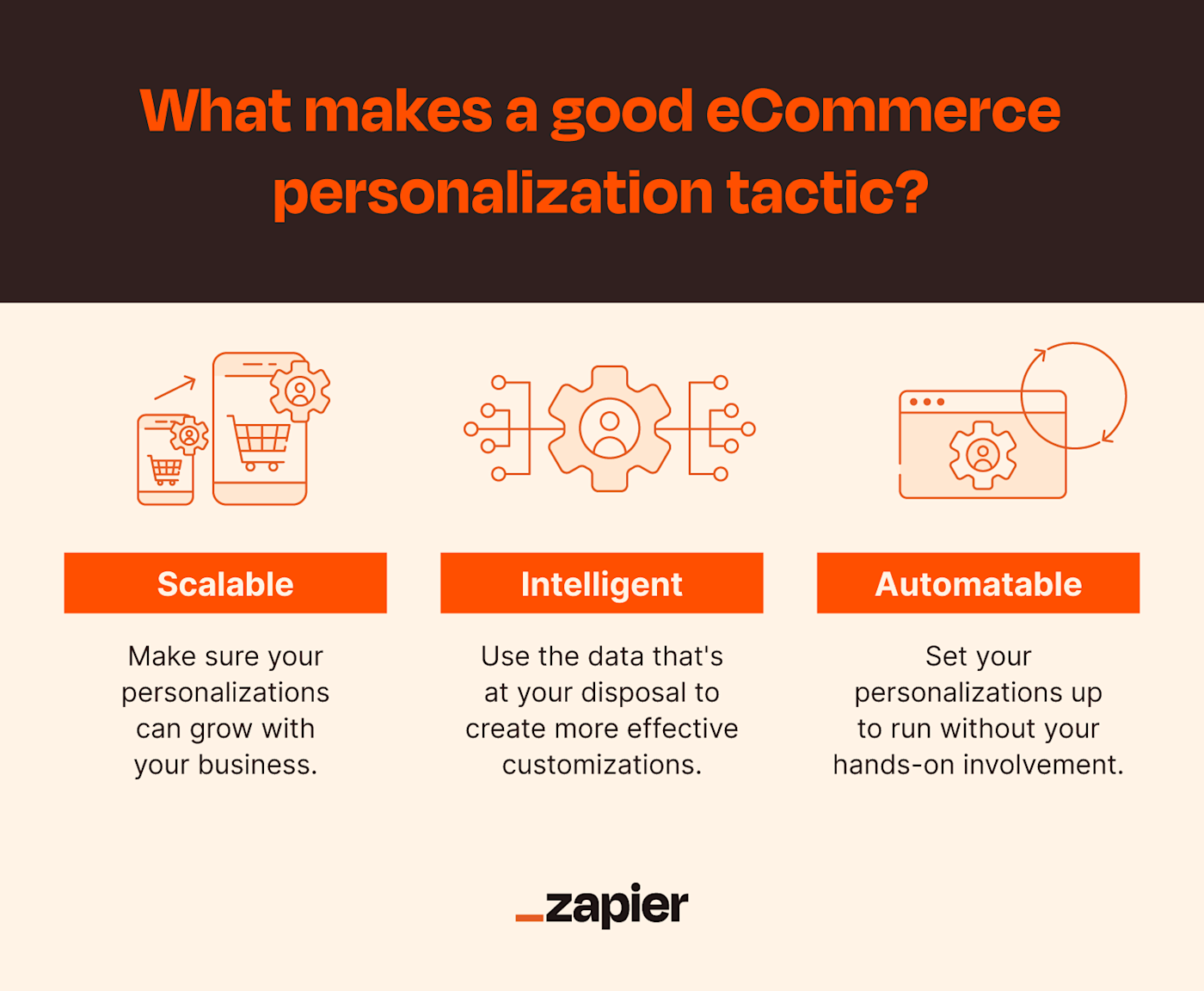
11 eCommerce personalization ideas
Now for the good stuff: what cool things can you do to customize your eCommerce shopping experience? These are just a few ideas to get your juices flowing, and by no means should you limit yourself to them—personalization is a place where you can really express your creativity and brand identity and test out new ideas.
1. Personalized product suggestions
Do your product pages include related product recommendations? Often these lists are based on seller-side data—e.g., what products are most frequently purchased alongside whatever product the user is looking at right now. But a smarter approach would be to base your recommendations not just on your own seller data, but on this individual customer’s buying and browsing history.
An example in action: because I crouch like a goblin when I’m working at my desk, I’ve been eyeing this absolutely absurd office chair for some time now.
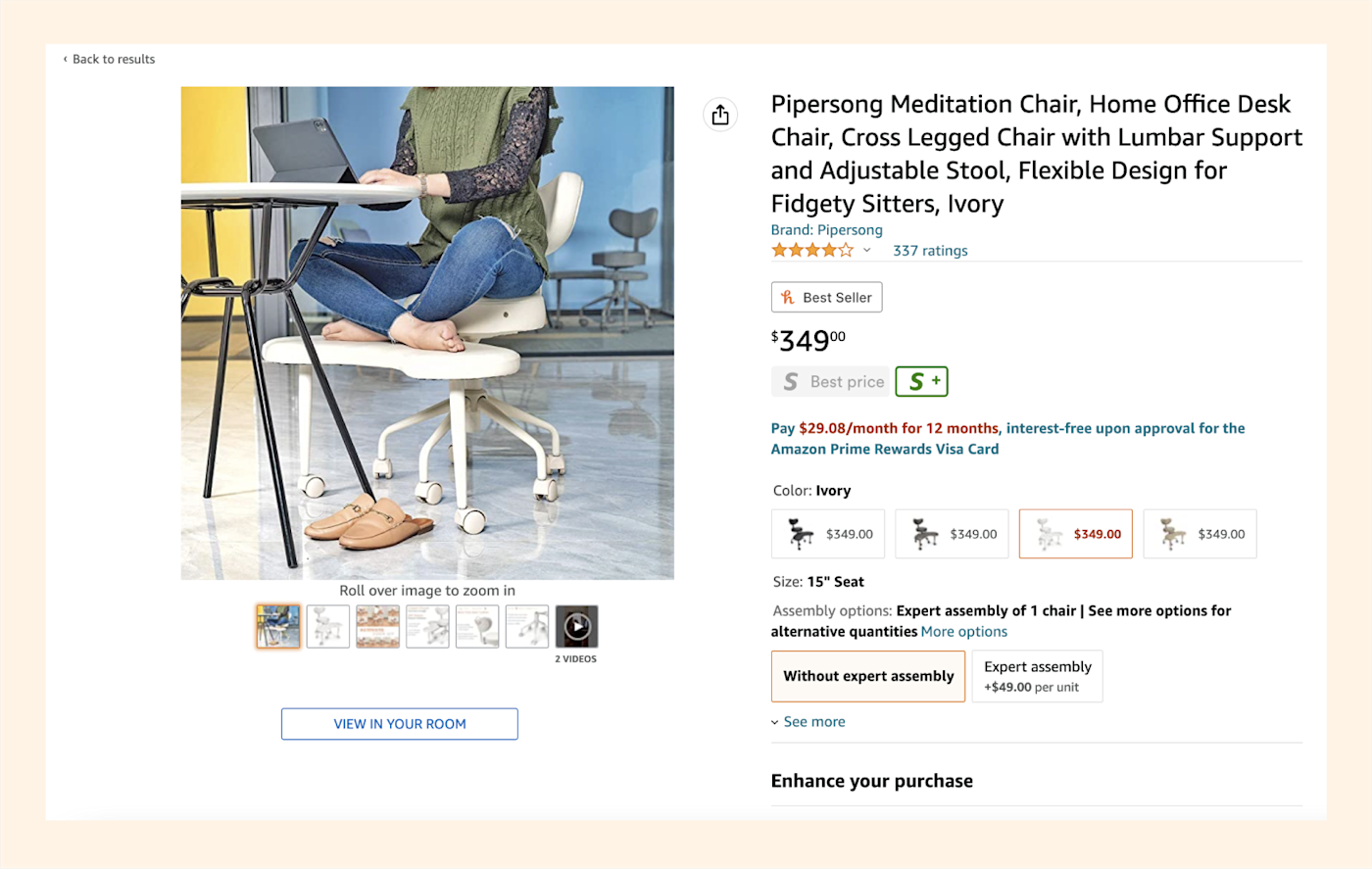
I may think this is the world’s most perfect goblin-posture chair, but what if there’s a better one, or a similar-enough one at a lower price point? If I were on the fence in any way, the “Based on your recent views” section, which is personalized to my viewing history, could still result in a sale by showing me a product I’m ready to hop off that fence for.
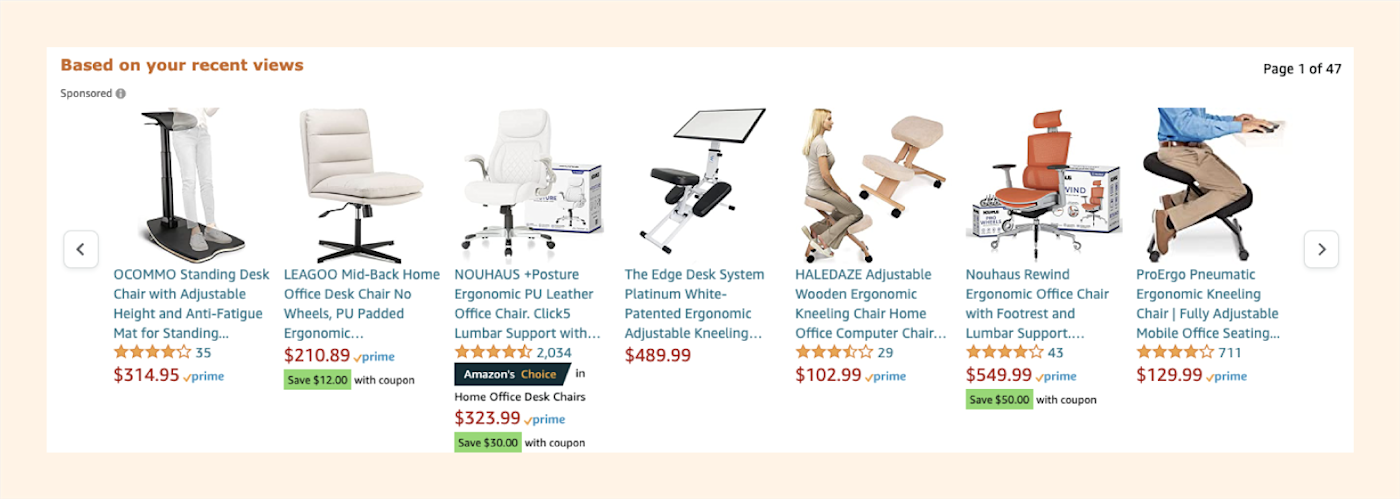
Just because Amazon does it, doesn’t mean you have to be Amazon to add the same feature to your online shop. The top eCommerce platforms should offer this sort of functionality so you can start utilizing user shopping behavior.
2. Timely discounts
Just as I’m more likely to buy one of the recommended chairs above than the super-expensive one I really want (sigh), buyers are most susceptible to deal offers that meet them at the right place at the right time. Spending $175 on an office chair is still pretty ridiculous considering I have a perfectly good (albeit traditional) one already, but in the context of my browsing really expensive chairs, it feels like a comparatively good deal.
You can use the same data that drives personalized product suggestions to target customers with discounts that match what they’re shopping for. You want to time these offers strategically—there’s no point in offering a discount to someone who was ready to pay full price. But if your abandoned cart automated email or your exit banner contains deals on whatever’s on your customer’s wishlist, you may tempt them to make a purchase they were getting ready to pass on.
Here’s what that can look like IRL.
Just after the premiere of this long-awaited show, this convenient HBO MAX ad hit my Instagram feed.

Meanwhile, over on Facebook, Thuma followed up on my furniture shopping foray.
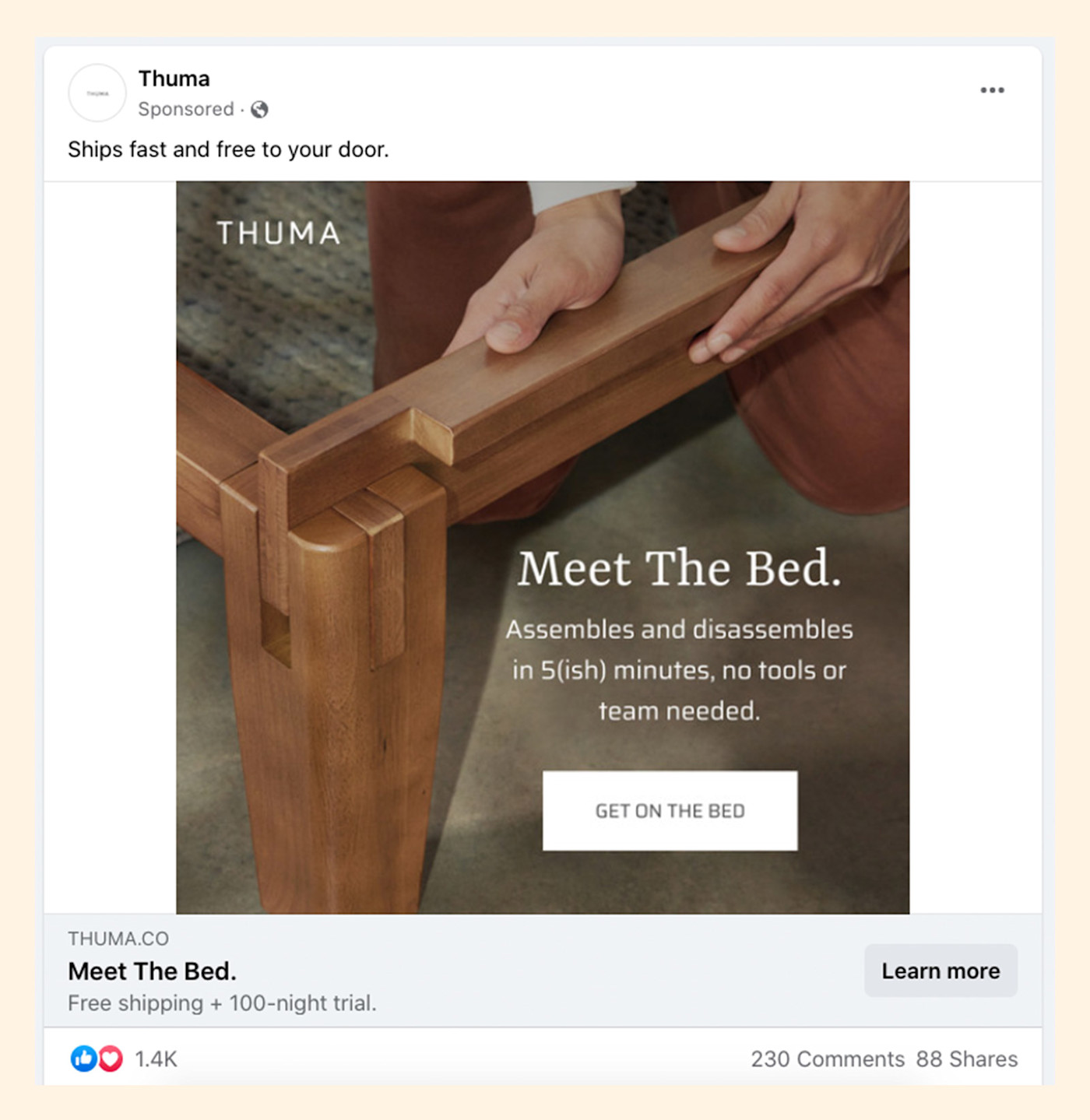
And in my inbox, an email from Way offered a solution I didn’t know I needed after I booked a flight.
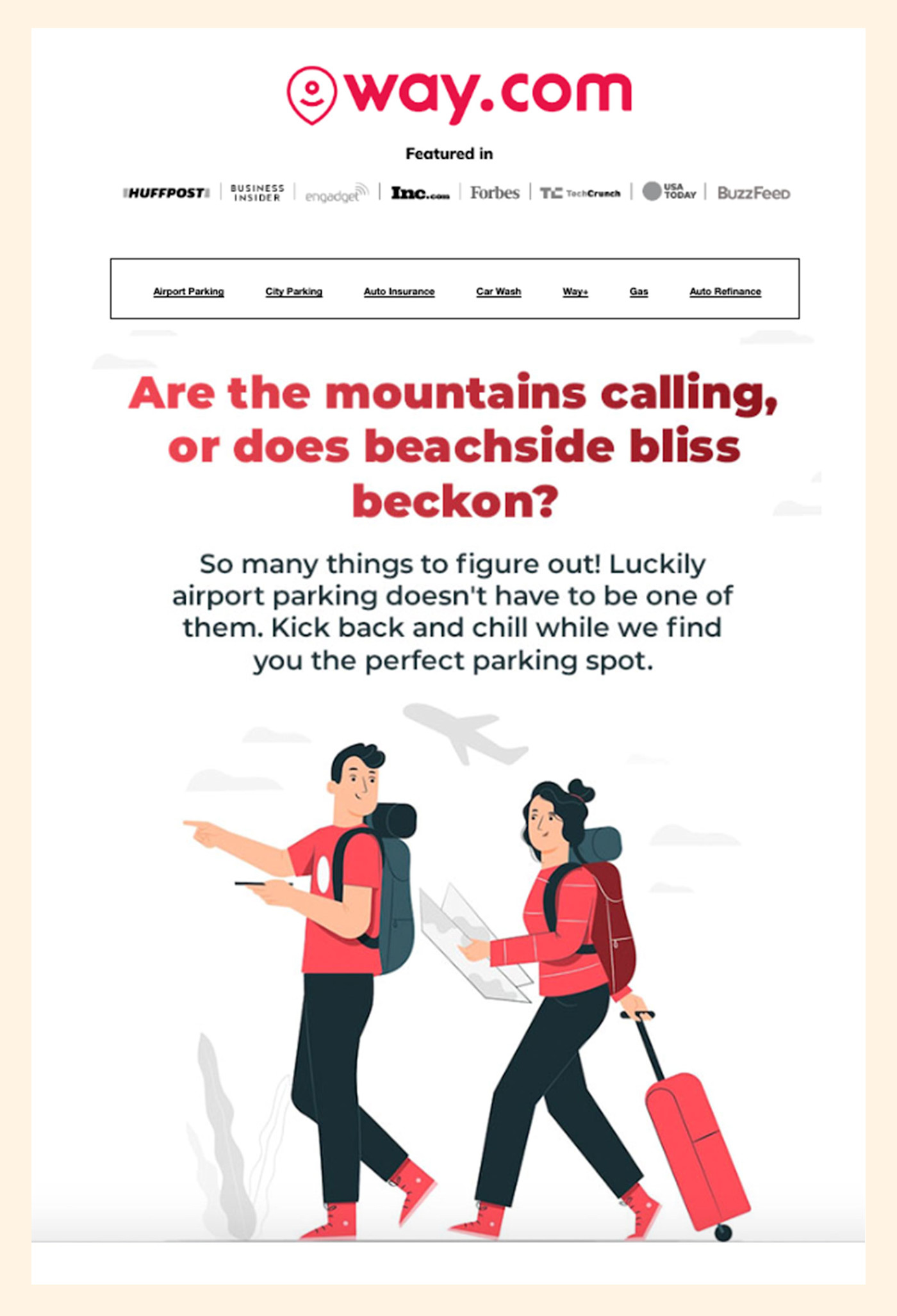
3. Target localization
The most common data category to use for personalization is individual behavioral data: purchase history, browsing history, email open rates, link click-throughs, and so on. But you can also personalize the shopping experience geographically.
For example, you’ve probably experienced the influx of Pride-themed marketing that lands in everyone’s inboxes each June. But I live in San Diego, where Pride actually takes place in July. (There are so many major cities in California and only so many parade floats and food trucks to go around.) So far, Target hasn’t caught on that they should be sending me those discounts a month later than they usually do.
You can do this for micro-events, too. If I lived somewhere with a distinct storm season (it truly never rains in Southern California), a savvy pet supplies shop owner, who knows from my purchase history that I have a dog, might keep an eye on the weather and send me an advertisement for a doggy ThunderShirt in the days before the dreaded stormy weather arrives.
4. User-generated content (UGC)
Here’s a way to make the most of someone’s customer data: run your ads on social media platforms that already do most of the targeting work for you. Instagram and TikTok, in particular, work very hard to make sure that their in-app shopping opportunities blend seamlessly with each user’s interests. Run your ads there, and let them do the work of finding your prospective customers.
This works for professionally produced ads, but what’s even more effective is promoting user-generated content, or social content that your buyers created on their own. Influencers are required to include the “#ad” tag on paid promotions, so when I see content that doesn’t have that, I know that the creator is posting about that product for no reason other than that they love it.
To really make the most of your social presence, with Facebook Custom Audiences, you can even use your own existing customer list to create targeted ads on Facebook to continue growing both your list and your Facebook audience.
5. Social retargeting
With social media, you can also use some strategic timing to make sure your ads land on the right account timelines at the right time. The principle here is the same as cart abandonment emails: target users who have recently shopped your store or have been engaging with your emails and other content.
The more you appear in your customers’ day-to-day lives, the more likely they are to make their way down the lead generation funnel and make a purchase.
6. Post-purchase thank-yous
It may seem to customers that the purchase is the end of the ride, but as brands, we’re always hoping those customers get back in line afterward for another go. But if you’ve ever purchased something you love—a boutique dice set, let’s say—and then found yourself wondering months later where you got it, you know even happy customers may not automatically return.
Repeat buyers often need to be nurtured by being reminded and incentivized to come back. In a crowded online marketplace, they may not explicitly remember your store name, which is where post-purchase check-ins can help. Following up with a thank-you offers three major benefits:
-
It helps keep your brand top of mind for customers.
-
It can incentivize customer reviews.
-
It can incentivize repeat purchases.
If you can nail all three benefits, you’ve achieved perfection. A great follow-up on a successful sale might include a link to a review form (like your Google My Business page), a one-time discount on their next visit, or both.
Here’s an example thank-you email I received from Insomnia Cookies after purchasing a birthday gift for a colleague.
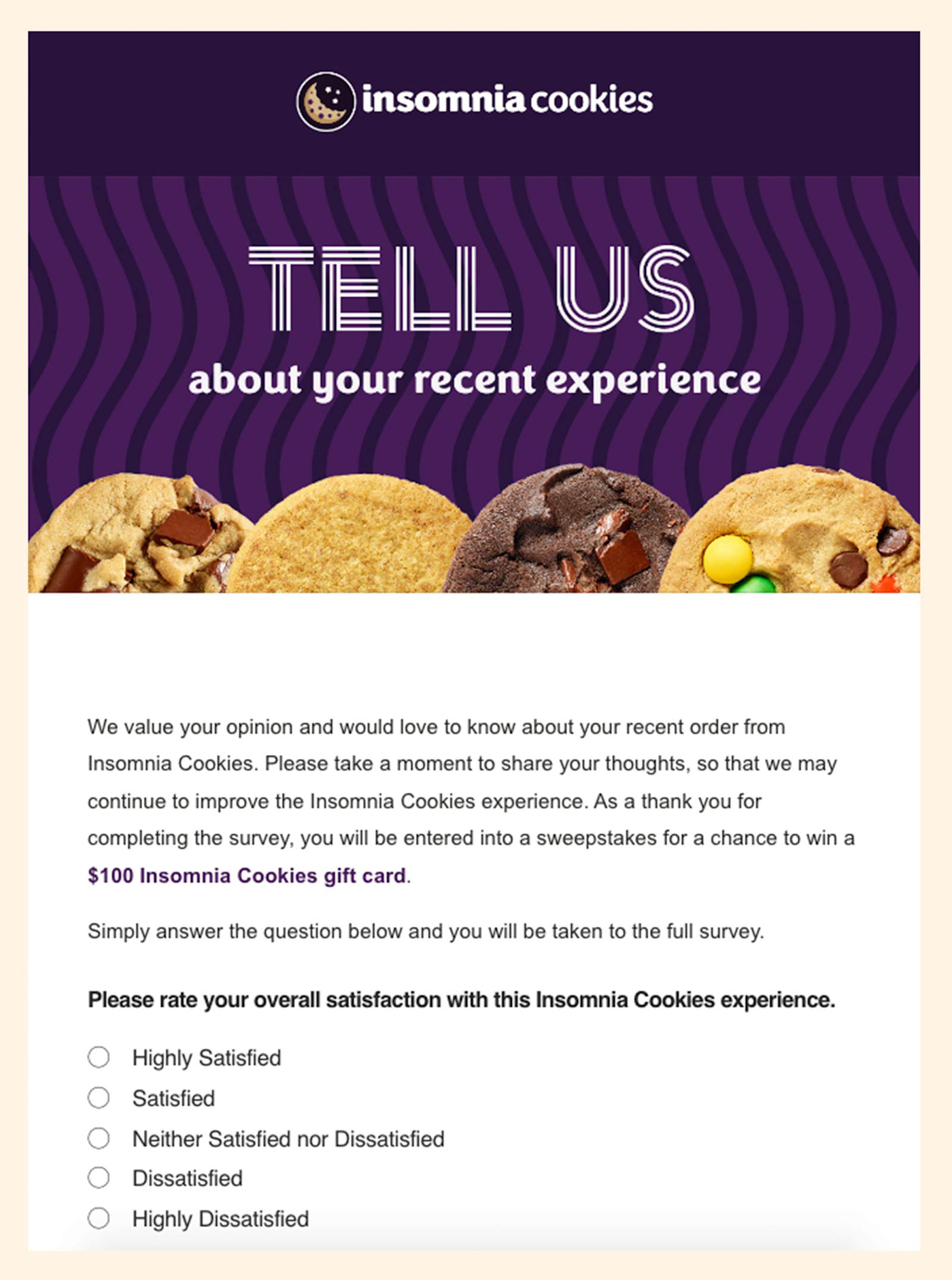
By automating thank-you campaigns, you can easily work this tactic into every sale.
7. Curated bundles
Let’s play a game. It’s called “Log in to Spotify and Tell Me What You See.” I’ll wait.
If you played, you likely noticed most of Spotify’s homepage real estate is dedicated to playlists curated by staff and algorithms. These playlists account for nearly a third of their listening time. Of that listening time, about half is dedicated to algorithmically curated playlists based on users’ listening history.
Spotify may not be an eCommerce platform in the same way as your business, but the principle is valuable. They have tens of millions of songs (read: products), and that sort of catalog can be overwhelming. Unless users come to the platform with a specific song (product) in mind, they need somewhere to start.
By creating similar curated product bundles with themes, you can improve users’ shopping experience. Consider adding seasonal bundles (Beach Vibes, All About Autumn, Spring Must-Haves), holiday collections (Ghoulish Goods, Here for Hanukkah, Cozy Christmas), or other topical themes specific to your products. Heavy alliteration not required, but encouraged.
8. Recent bestsellers
Going back to Spotify, their most popular playlists show users love culling those 70 million song choices down to a handful of the most popular picks. Today’s Top Hits and Global Top 50 account for 43.67 million followers, which, if my math is correct (always a risky proposition when 10-sided dice aren’t involved), accounts for a quarter of the top 20 most-followed playlists’ followers. Researchers have demonstrated the same concept in non-Spotify contexts too.
You can probably already see how this can apply to your eCommerce business. If you sell many products, personalized bestseller lists can offer shoppers a convenient way to whittle down their options quickly.
A good example of this is Sephora’s “Bestsellers” pages. Sephora provides a general bestseller page but also links to pages with tailored products under categories like makeup, skincare, fragrance, and more.

Just like Spotify listeners, beauty product lovers may appreciate being able to get straight to the most popular products.
9. “We miss you!” re-engagement messages
Who doesn’t want to be missed when they’re gone—especially when it means 20% off your next purchase?
Given that the cost of acquiring new customers is vastly more expensive than that of retaining existing ones, reducing these losses represents a major revenue-preserving opportunity. Re-engagement tactics, like the “We miss you!” message, incentivize past and would-be customers to stay loyal or continue with their purchasing journey.
A successful re-engagement campaign should be relevant and valuable. By offering data-driven recommendations based on user browsing behavior to cross-sell or upsell, or by incentivizing returns with discount codes, you can make your brand’s presence felt and potentially turn inactive customers into return customers.
10. Targeted on-site pop-ups
Pop-ups are at their most effective when they’re catered toward specific users according to their browsing habits and their position in the sales process. Here are a few examples of targeted pop-ups that meet users where they are:
-
Discounts to new users for their first purchase
-
Discounts in exchange for newsletter sign-ups to users who have browsed but didn’t add to their cart
-
Free shipping above a spending threshold for users with items in their cart totaling below that threshold
-
Abandoned cart reminders to users with items in their carts
-
Welcome-back offers to returning customers
-
Browsing history reminders to returning shoppers
11. Customer review engagement
When’s the last time you were so thrilled to buy something you didn’t even need to bother reading reviews first? Since basically everyone uses reviews to guide purchasing decisions, eCommerce marketers would be smart to work this into their personalization strategy.
At the post-purchase phase, reviews affect customer experience by allowing you to maintain engagement with happy customers and potentially atone for flukey sub-optimal buying experiences. At the pre-purchase phase, reviews (and your responses) influence the way would-be shoppers perceive your brand.
Engaging with users shows that your business sees them and values them. And by automating review follow-ups, you can easily store and respond to reviews with maximum efficiency.
Getting the most out of eCommerce personalization
To recap, the key for a great eCommerce personalization campaign is to ensure it:
-
Remains scalable as your business grows
-
Is intuitive and catered to individual user behavior
-
Can be automated as part of your sales process
Personalization can lock down that first sale with a customer, but it really shines as a customer retention tactic. Whether your campaign includes all of these ideas or only one of them, it has the potential to create and nurture a lifelong fan of your brand—or at least just a repeat customer.
In the meantime, I’ll be waiting for the handwritten thank-you note.
[adsanity_group align=’alignnone’ num_ads=1 num_columns=1 group_ids=’15192′]
Need Any Technology Assistance? Call Pursho @ 0731-6725516







